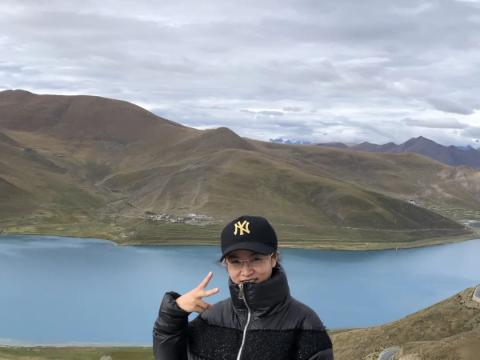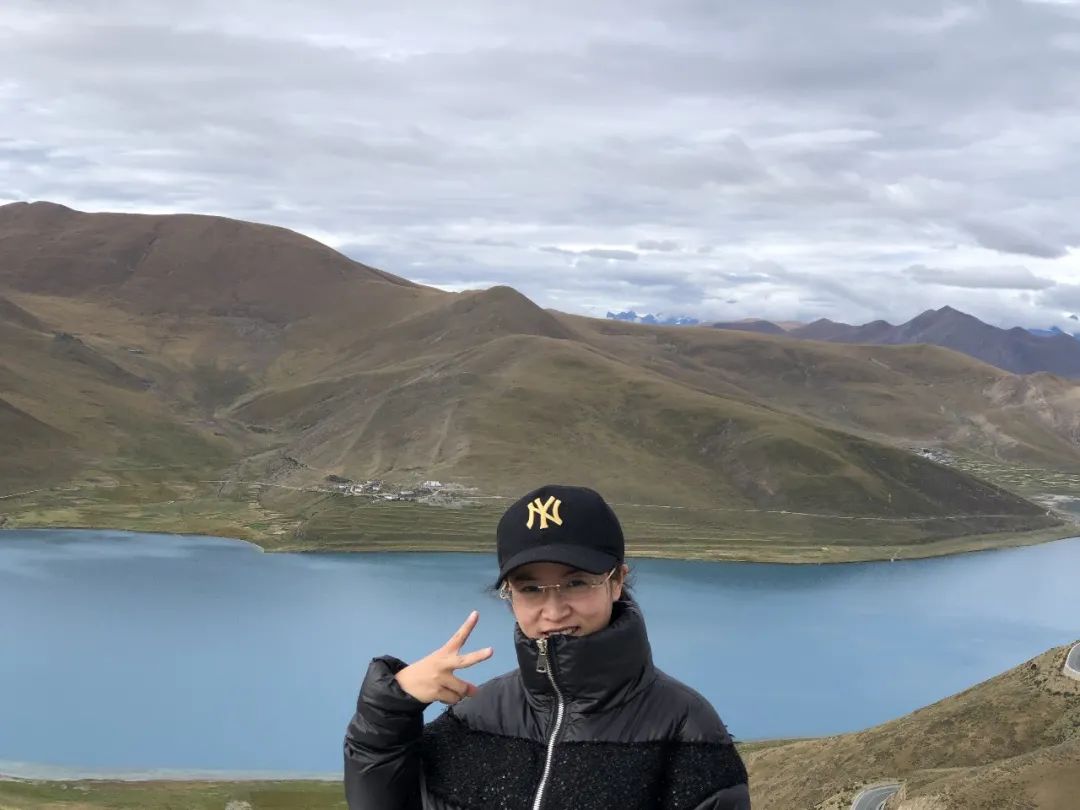
01——Yamdrok Yumcuo
Today we started our trip to Tibet. We set off at 7:30 in the morning, got on the bus and drove to Shigatse City. On the way we had to pass through Yamdrok Yumco and Kanola Glacier, and finally arrived at Tashilhunpo Monastery in Shigatse.
After more than two hours' drive, we arrived at the first stop - the beautiful Yamdrok Lake. Looking down from it, you can't see the end at a glance. It is more than 600 kilometers long and the deepest point is 60 meters.
Looking at Yanghu Lake from a high place, there are many bifurcations, and it is difficult for you to see the whole lake. The water is green and the mountains are strong. Tourists click the shutter one by one to capture the beauty of Yanghu Lake in their cameras.
There is a stone monument of Yamdrok Yumcu here. Tourists are vying to queue up to take photos with it, proving that they have visited this place. I stood high and looked at Yanghu Lake, feeling how beautiful and peaceful it was.


It is a dead lake with no water flowing in or out. Its water is collected from the melting of snow-capped mountains.
Tibet is a pure land that has not yet been destroyed, so today we can see such a green and peaceful Yanghu Lake, with many Mani piles next to it. This is everyone's wish, praying for peace and prosperity.
Our group of people went to the lake under the guidance of the tour guide. I also brought back a bottle of Yanghu water in a mineral water bottle, which means good luck.


Of course, there are many experience projects, such as taking photos with Tibetan mastiffs, riding on the back of a yak and walking into the lake to feel the taste of the yak. There are also paid projects for posing and singing at a poster 5,000 meters high to help you record Video and take photos to become the most beautiful person in your circle of friends.

You are also inseparable from the Tibetan friends who have been selling stones to you. The posters of this place are very high, and they can only do business for a few months in a year, so when they see tourists coming, they will follow you closely. peddling his wares.
Of course you can choose not to, but never touch their items. If you don't want to buy, please leave quietly and don't joke with them, otherwise they will take it seriously.
Tourism in Tibet opens up a connection between Tibetans and the outside world, bringing in good and bad things. Now the country encourages everyone to travel to Tibet, which is also a way to aid Tibet.
02 - Canola Glacier Pass
Then we sat on the road for another 2 hours. Along the way, we passed 99 turns as Han Hong sang Tianlu. Master slowly drove us to the Canola Glacier Pass. We saw the snow-capped mountains. Arriving at the filming location of the previous movie "Red River Valley", the snow-capped mountains stood in the clouds.
I stood at the foot of the mountain and felt the cool breeze on my face, the wind brought by the snow-capped mountains.
After taking the photos, we continued to take the bus. First, we had a simple group meal. After lunch, we started our afternoon trip - Tashilhunpo Monastery.

03——Tashilhunpo Monastery
When talking about this temple, we have to mention a Panchen - the 10th Panchen. Everyone knows that the Panchen or the Dalai Lama cannot get married and have children, but the 10th Panchen got married once and had a daughter. So why did the 10th Panchen Lama get married and have a daughter? What about the Panchen Lama getting married and having children?


This happened after the 10th Panchen was recognized as the 90th Panchen, when he was 11 years old. At that time, the Communist Party and the Kuomintang were at war. At that time, Chiang Kai-shek wanted to take away the 10th Panchen, but he did not side with the Communist Party and had no choice. The Kuomintang chose Tibet instead.
Because he said, I don’t care if you are the Communist Party or the Kuomintang, I am a Tibetan citizen and I am in Tibet. So he hid for two years. Later, he investigated the policies and culture of the Communist Party, and then wrote to the central government. Finally, he contacted important figures in the central government and worked together for many years.
It wasn't until the Cultural Revolution happened when he was 29 years old that he was arrested and imprisoned for 9 years and 8 months because he wrote a heartfelt letter as a friend of the party.
Later, with the death of Chairman Mao, the succeeding national leaders discussed and decided to release the 10th Panchen Lama, but they had to agree to two conditions:
The first is to remove the identity of a living Buddha and exist as a Beijing citizen;
Second, we cannot leave the confines of Beijing.
The 10th Panchen Lama agreed to these two requests because he still had very important things to do in his heart, which was to develop Tibet well so that everyone could have food to eat and have sustenance. So it's better to have some freedom than to be in prison.
What is admirable about the 10th Panchen Lama is that he did not give up on himself in prison, but devoted himself to studying, learning Chinese, practicing calligraphy, reading scriptures, etc.
This is an open-minded spirit when facing difficulties, actively facing difficulties, tempering oneself in difficulties, and making oneself stronger and better.
04——The 10th Panchen Lama
Facts have proved that the 10th Panchen Lama made a great contribution to the development of Tibet. He built several Panchen Lama temples that were destroyed by the Red Guards during the Cultural Revolution. Not only that, he also reached many plans with the central government to develop Tibet.
Now when you come to Tibet, you can see the five-star red flag on every house. In every city in Tibet, there are sister cities built with counterpart assistance. For example, the Shigatse we are in today was built with the help of Shanghai and other cities, so you will see many roads named Jiangsu Avenue, Shanghai South Road, etc. Our current form of tourism is also a way to help Tibet develop.
The 10th Panchen Lama passed away in his palace on January 28, 1989. He was very anxious when he left and left without any pain. In the hearts of the Tibetan people, the 10th Panchen Lama passed away successfully, and his contributions to Tibet are deeply imprinted in the hearts of the Tibetan people.
During the ten days since he came to Shigatse, the 10th Panchen Lama did a lot of things. He went to many surrounding counties and cities, touched the heads of more than 300,000 believers, and prayed for them.
Today we saw the Temple of Heaven where he was buried. It was built with hundreds of kilograms of gold and countless gems. In the middle was a life-size statue of the 10th Panchen Lama. The round part above is where his real body is, which took several years to dry and maintain.
As for how to deal with the Panchen Lama's body, it involves medicine, chemistry, pharmacy and medical beauty. It is probably necessary to dry it first, not only the body but also the internal organs inside. Then the facial skin needs to be repaired and the contents filled. Finally, the body is as lifelike as it was when the 10th Panchen Lama was alive.

05——Houzang’s faith
Whether it is the Panchen Lama or the Dalai Lama, the size of their pagoda burials is determined based on their contributions to the Tibetan people and the economic development at that time. However, in front of the Living Buddha, all sentient beings need everything to be well.
So when we pray, we can pray that all children in the world may be healthy, happy, and safe.
Everyone worships the Buddha devoutly. When you see such a vivid, compassionate and wise Buddha, you can't help but close your hands and worship the Buddhas.
We also saw a lot of monks. Zha Shi Lunbu Temple is now a Buddhist academy, so you will see monks wearing red robes everywhere. In a space, you can see many monks sitting together, ranging in age. .

Most of them are sent to study Buddhism when they are young. When they reach the age of 12, which is the age when we say they graduate from primary school, the master will conduct an assessment. Children who have understanding of Buddhism will be selected to stay and continue to study. Those who do not pass the assessment will be allowed to study. Parents take it back. This is how a master finds his disciples. Once the master-disciple relationship is established, the master will be responsible for you.
After the death of the 10th Panchen Lama, the central government secretly searched for the reincarnation of the 10th Panchen Lama. After a complicated and mysterious process, the current 11th Panchen Lama was determined.
The 11th Panchen Lama is 30 years old this year. He was born in 1990. He is the religious leader of Tibet. Today he is in Shigatse City. Every year he comes from Beijing to Shigatse City to preside over large-scale religious activities.

From generation to generation, spiritual civilization and religious beliefs are passed on. Believers worship Buddha and religious leaders devoutly, believing that Buddha will bless everyone with health and happiness.
You will see that there are various gifts for Buddha in the merit box, including money, pens, cola, fruits, etc. Buddha will accept anything. This is the power of faith, accepting all people and praying for all people.
We all know that in order to become a Buddha, we need to purify our six roots and abandon the three poisons of greed, anger, and ignorance. The six roots refer to our five senses and heart. Without greed, anger and ignorance, we should be kind to others, be good people and do good deeds. Because when a person dies, he cannot take anything with him, only his karma.
This karma is divided into good karma and bad karma. Good karma means doing what you should do and not doing what you cannot do. Bad karma is the opposite, not doing what you should do and doing things you shouldn't do.
Listening to the tour guide introducing the history of Tashilhunpo Monastery and understanding the religious culture and beliefs of the Houzang area, you will marvel at the power of faith. Everyone practices, everyone is good, simple and innocent.
After more than an hour of listening and watching, the trip to the religious place in Houzang is over, but the inner cultural journey has just begun.
